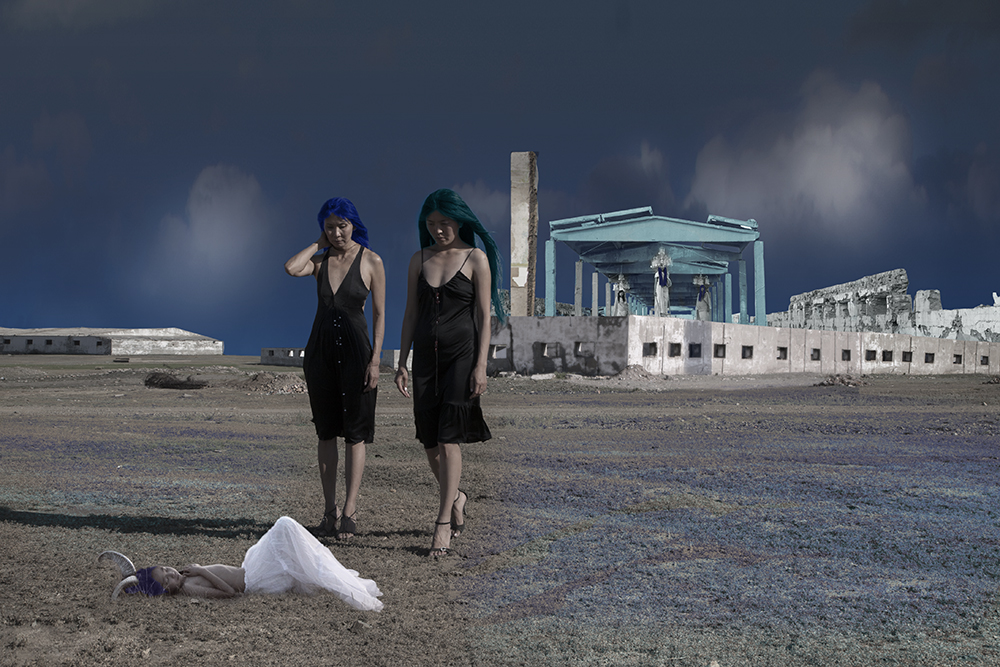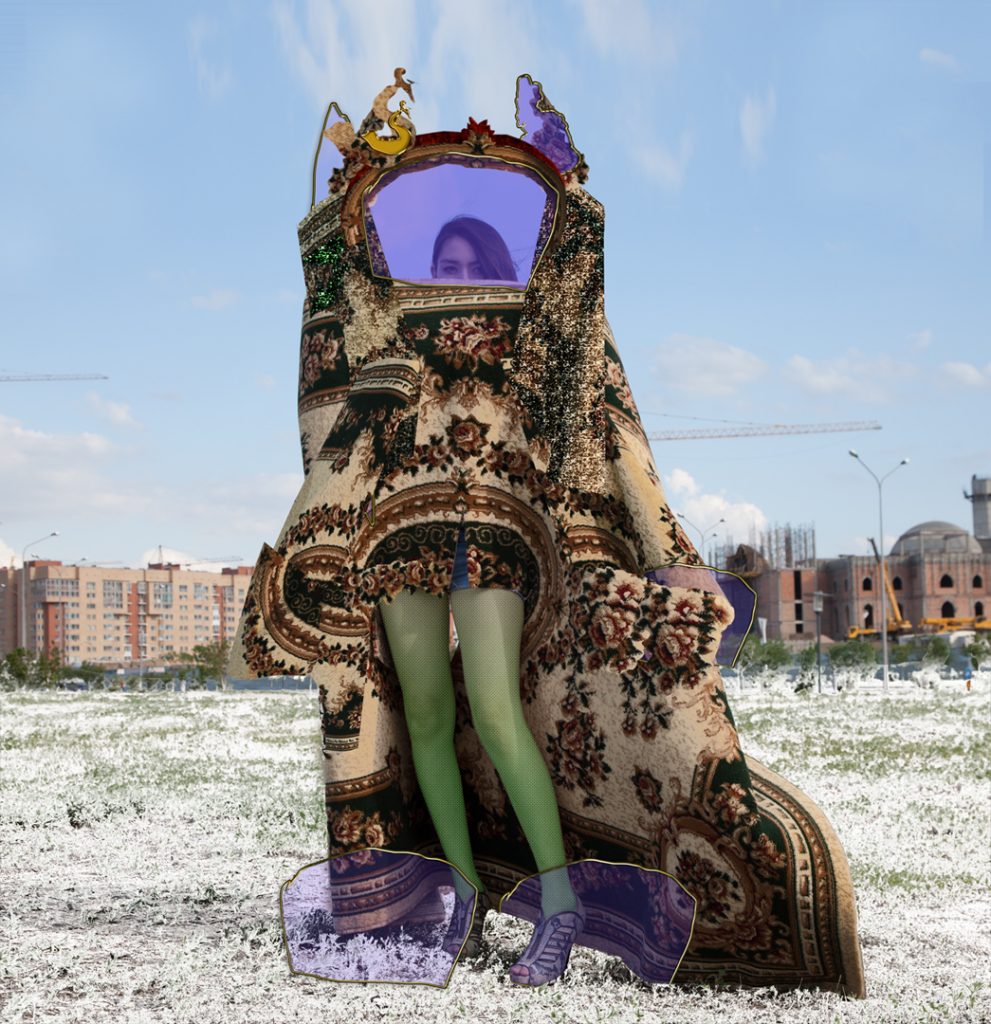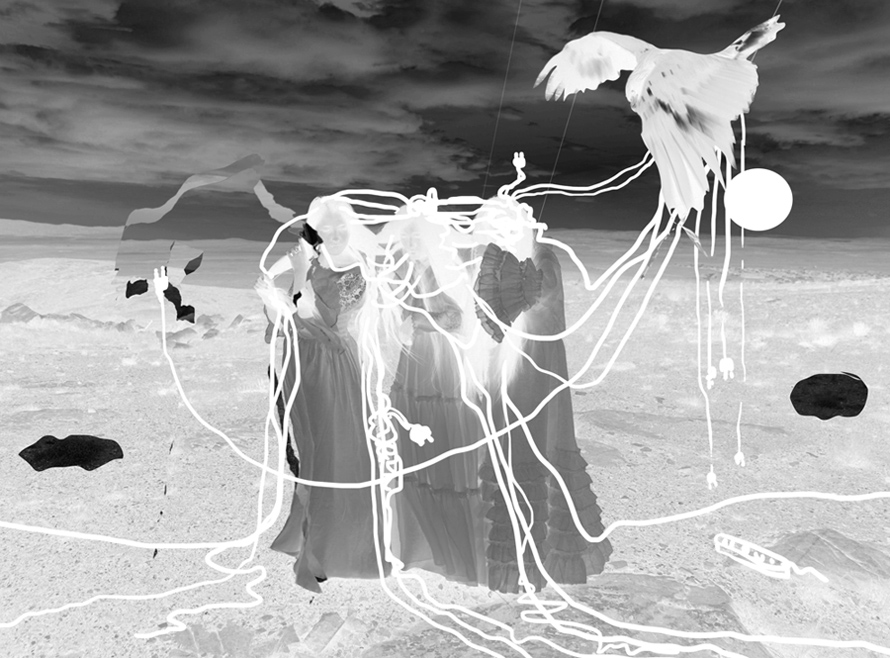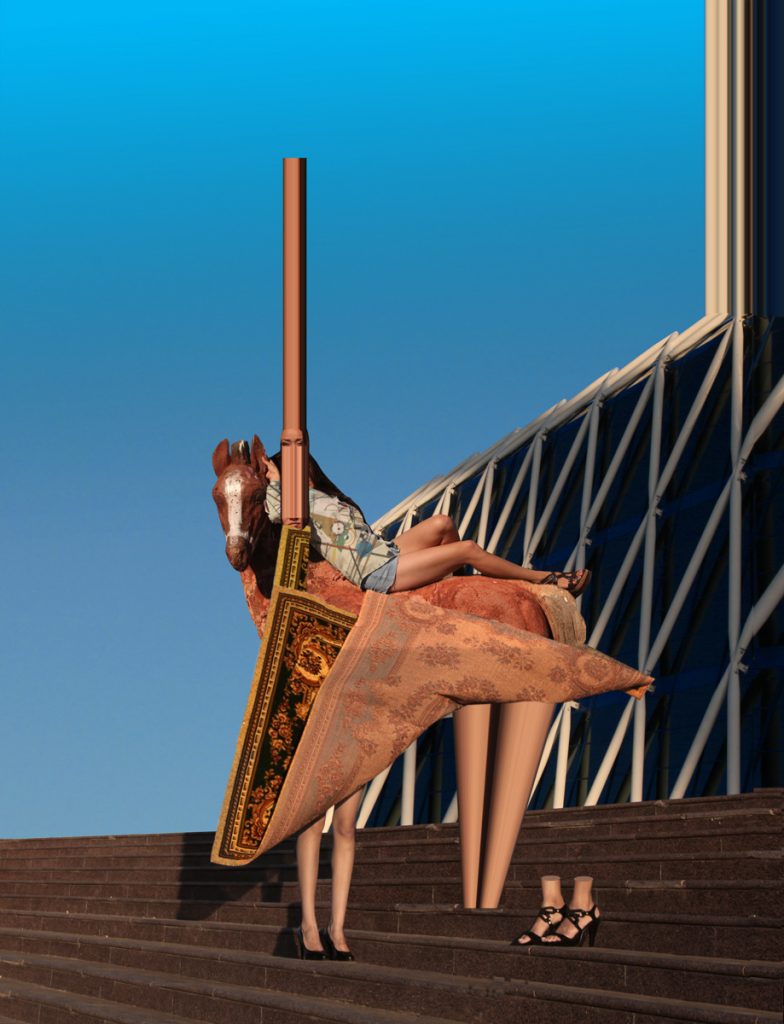
Almagul Menlibayeva is a multimedia contemporary artist (site-specific multi-channel video installation, photography, digital media) and curator. Born in Kazakhstan, she lives and works between Germany and Kazakhstan; Since 2003, she has been collaborating with the sound artist and composer OMFO (German Popov, Amsterdam); 1988-1995 was a part of the Almaty young underground artist’s group movement Green Triangle; 1988-1995 Collaboration with the Kazakh artist Sergei Maslov.
For this occasion, Huma has a conversation with Almagul, which was then transcribed.
You live between Kazakhstan and Germany. Did the pandemic affect where you were based? How did you navigate through it all?
I started to hear about the pandemic when I was in Lahore; the Biennale had just finished. So, I left Lahore, and it was then that we really started to realize how careful we had to be with traveling. It wasn’t easy to think about where to settle and wait everything out. I had a project in Brussels where I was meant to be doing many technical things: a video work – and I took all my drives – it was a lot – critical hard drives, and then I was between Brussels and Berlin mostly. Everything was canceled. I started to do animation with a SketchUp program, so I continued doing that and drawing and painting. It helps me overcome feeling in a claustrophobic space, not going out and thinking more about working inside. Often our resources and inspirations are taken from outside: sharing with people, etc., so it was interesting to see how this would be possible when we are confined. It was strange learning how to communicate with zoom and how you see yourself. We had to adapt, and everyone was learning how to communicate and live the way they wanted but in a totally new way. Everyone moved into the new digital! Everything went online, and this became our social space. I became more interested in how people can change/how to be healthy and be simpler. Why it might be harder to be more productive and so on. The environment meant we had to rebuild our habits. Seeing that everyone is suffering makes it a unique experience: it becomes extra sensitive.

Pantheon (2020), 71×107 cm. Inkjet print on archival paper. Courtesy of Almagul Menlibayeva© 2020.
Your work has a nomadic aesthetic, as you also travel a lot. How has your approach to work shifted in the last year and a half? Did you create a new body of work?
I “travel” or “nomadize” between mediums. I construct my works from different mediums. I am connected to my body through drawing; I dismantled and replaced them with different media.
When the borders were closed, I dived into my digital sketches, developed my SketchUp skills for the animation to finish my project with PCAI about Space Trash and Ulugh Beg astronomer from Samarkand.
I feel like creative people, and cultural phenomena have to humanized technology: many digital products at the beginning were developed by the military as tools to defend for control or conquer. The humanization of these tools starts with artists’ play and brings the idea of how they can be used. And 2020 was a big rethinking for me.
Once during my filming travels, I had an unforgettable conversation with a unique woman Master Bifatima from Turkistan: “I won’t repeat myself and my successful experience, every day I chose what is experienced is not as expected. ” Her words and experience have always been my guiding principle, but during the Lockdown, they became the main motto.
The lockdown brought me a memory of when I used to have a studio with many stuff/paintings, felt works, objects. The moment when I rethought my cultural materiality: to be minimal in many ways. I moved into the digital realm in 2003: performances, videos, photography: it was a very natural move. I like the variety of different mediums. It is always interesting to see how to move with the time and how we update.

Flying Carpet Sci-Fi (2020), 71×107 cm. Inkjet print on archival paper. Courtesy of Almagul Menlibayeva© 2020.
This links to my third question, which I think you have answered part of: what is your preferred artistic medium? Do you see crossovers between your video and photography work? For example, can you start sketching digitally, and then another idea comes up, and you decide to do video/photography or something else?
Yes, that’s right. I am very well connected to my body through drawing. During the process, I dismantled and replaced the parts of the drawing with different media. If I don’t have any skills for some media, it makes it an inspiration for me for new experiences.
The image connected to my drawings, the drawings connected to my body, the body connected to performance, the performance brought me to video and photography, and so on.
At the beginning of my art practice, I was simultaneously engaged in two different media – painting and textile design (I am a textile designer by education). Both are so different, but with time by questioning, I managed to construct both experiences into the digital field as video art and photography. I synthesized the idea of becoming like a “Digital Fabric thinks,” which gave me a lot of freedom I create another space.
One of my sources of inspiration was a conception of the architecture of the yurt, the house of nomads. I started looking at the urban building like a “fabric.” My first video works were about fabrics of nomads enveloping the architecture of the body groups of people, Earth. For me, these siftings build the media video as the “Fabric of the Time” or drawing by light in a dark video room. Later developed into a multichannel video installation.
My photography is constructed from the stories and concepts of videos. In other words, my photography is generated when “Fabric of the Time” is edited as a video. I collected many photographs, and some of them I keep in ” unborn state,” which is spontaneous when I do not give it any assessment and do not pass it through the learned experience. The Image stays beyond all media. Image has power, and sometimes so much we fully can’t understand it.
When you talk about strong imagery, we have been brought up with folklore and stories in Turkey. That builds up the imagination and a way of thinking of certain mythical creatures.
Your body of work is embedded by historical, mythical future aspects of the Caspian sea with wider Kazakhstan – where you come from. I would love to hear how that came about and where you are heading?!
The idea of working with the construct of mythologies in my artistic practice came during my studies at the Art Institute in Almaty at the Faculty of Textile Design. This may have come to me unconsciously, as an internal protest to the political technology of creating an ideological image. I must say that Soviet technology has become an example for many modern totalitarian and radical regimes.
As opposed to it, my research into the history of nomadic textile design gave me a boost to the research for the concept of the Art of Motion. My attention was attracted by ornaments and symbols on fabrics from overland Trade Routes from Siberian Altai to North and South America through The Bering Strait between Pacific and Arctic oceans and Central Asia, Persia, Ancient India, Middle East. The routes that were before the “famous” Silk Road between Europe and China.
In 1995, I made a series of felt panel paintings consisting of 12 large works 180×150 cm. One of the inspiring figures in this project for me was the books of the famous Kazakhstan archaeologist Alan Medoev (1934-1980)
The project is about zoomorphic female images migrating with myths and fairy tales in coats of arms, logos, and ancient ornaments.
In the process, I found that sedentary patriarchy, hierarchies, and dogmas were established with the successful development of technology. The previous scenarios of the fate of the mythical female heroes were rewritten in a new ideological way, you know, it’s almost like in modern television series, when it is necessary to change the fate of the hero to assert his position. For example, if in the nomadic economy and culture the independent position of a woman was a necessity of the economy, then in a settled way, this independence was not necessary for a woman and was condemned. This is how “bad” women, witches, barbarians appeared. The same happened in some legends with the Goddess Umai from the Tengrian worldview and with her assistants Peri (Fairy). These studies have become part of my video projects based on Feminist Archeology. An example of related female goddesses is Umai, the Greek Earth Goddess Gaia, or Pachamama-Earth Mother by Andes Indigenous peoples.
Since 2003, I have invited girls from Almaty to participate in my videos and performances, often from local peripheral locations, for example, from Aksu Ayuly, where my mother Gulbibi was from. I decided to re-create a connection with her land and between my art practice and the historical events that influenced her and me. These territories were once part of the Stalinist political camp for the repression of the GULAG; before that, with the advent of Soviet Power, there was a Holodomor, which took away at least 38% of the nomads. As I was shooting in the steppe, I realized for myself that in the historical context, the Stalinist Karlag and this huge network of Gulag repression camps were an attempt to build the Soviet economic Silk Road, where people worked in slave conditions.
To rethink these places anew, I decided to create space for female mythical images in my works, endowing them with special abilities through the processes of association and disassociation. I often worked with local girls, relatives, inviting them to project and create a common space for the future. I am sure that to change the future, one must realize the past. I thought a lot about this, and I understand that the depth of the threads into the past is different for each person. Maybe that’s why I set the task through my artistic shamanic practices to help develop the length of these liberating golden Umai threads. Some of my important works on these topics were Steppe Baroque (2003), Apa (2004), Milk for Lambs (2009-2010), Headcharge (2008), Transoxiana Dreams (2010-2011).

Lucid dreaming ( 2021), 100×97 cm. Courtesy of Almagul Menlibayeva.
Because you have lived abroad and talked about post-colonial theory with more international like-minded people, does this help, and when you go back, you see more clearly?
Yes, and also I recognise. Before, I felt it but couldn’t explain it.
” The 90s for me was a big moment for my mind-opening. In 1997 I had no place to live; by that time, my mother had died of an incurable disease, I was almost homeless. But I could buy myself from the Stalin`s era Soviet apartment by selling my own paintings and textile felt works. But by the local so-called “contemporary art of the Totalitarian Intelligences,” I was criticized for wanting to become a rich capitalist who sells bad fake art. I had a lot of negative feedback because of what a young Kazakh woman artist could not do! The basic human rights were put into question! I couldn’t explain but felt that if you are a prostitute, it is ok to make money, but if you are a woman making and selling art, it is wrong.
My present art practice began from my travels at the end of 90x and really helped me decide where to orient.
In 1997 I visited art galleries in New York and discovered that the overage American art people had difficulty identifying me, only with Russia or China, but did not know what Kazakhstan was. This trip revealed that the world still uses cultural information from the cold war on post-Soviet countries and the interesting time I live. But the same cold war mentality was inside of Kazakhstan, Russia, Uzbekistan, Kyrgyzstan. I`m aware that totalitarian legacies have left us with a radical mindset and cultural inequities.
I started to think about how I can be effective and enrich both sides of global contemporary art conversations.
Basically, already at the beginning, I came across decolonization topics questioning who I am. It is full of work, research and this is education!
I created a neogeography mapping based on my projects. I marked the filming locations from the Unique Caspian Sea area to Western Kazakhstan with the Nuclear Test Field and Central Asia.
I think the knowledge, like textile ornaments, creates its own maps, which do not belong to anyone; they have always had and will have free migration—for example, the migration of the royal totem patrimonial mark of a deer hoof from Siberia. Once, with the political elite and transformations, it came to Central Asia and the elites of Afghanistan and Iran. It became popular and known there as The Boteh ornament, migrated to India, and later, with colonization, migrated by the English military with the beautiful Indian fabrics on the shoulders of the English Kings. Its name has changed, but the magical form itself surprisingly keeps the pristine contour of consciousness.
Coming back to the present, this year, we celebrated the 30th anniversary of Kazakhstan’s Independence. Undoubtedly, a lot has been done, but I noticed that the natural, historical processes of Independence and decolonization are interpreted by some totalitarian legacy in the old way as supposedly nationalist processes.
I think the post-colonial theory with the new era of digitalization during Covid will have a stronger impact, and our collaborations and experience really need it.

Tomirys in Nur Sultan (2020), Courtesy of Almagul Menlibayeva.
That links to my next question, why female mythical creatures? So you’re saying they are not necessarily female or male; it is the context and how you approach the past to predict? Or re-mapping of the future? If you could time travel, where would you go and why?
For now, probably it would be good for me to go to Kazakhstan – to look into why so many have left and understand what happened. It has been such a one-sided story. I would be interested in being in the 15th century too!
For that time, a contemporary language of art was the ornaments, a unique way of communication, and the basis of abstract art! I am interested to know how people understand how we decode the 15th century and the difference between the two.
Are you working on anything at the moment? What are your plans?
I work on many projects at one time. One of them: digital – and graphic generators for texts/commercial selling – lots of designers use this. I mix with my work and practice and the history of Kazakhstan and former Soviet Siberia. I was invited to the Chinese Art Biennale, but they didn’t allow it because of my criticism of the Soviet Union. I am always looking at being a woman in these geographical locations also – this works well with my slow practice, which I take much time to research into.




